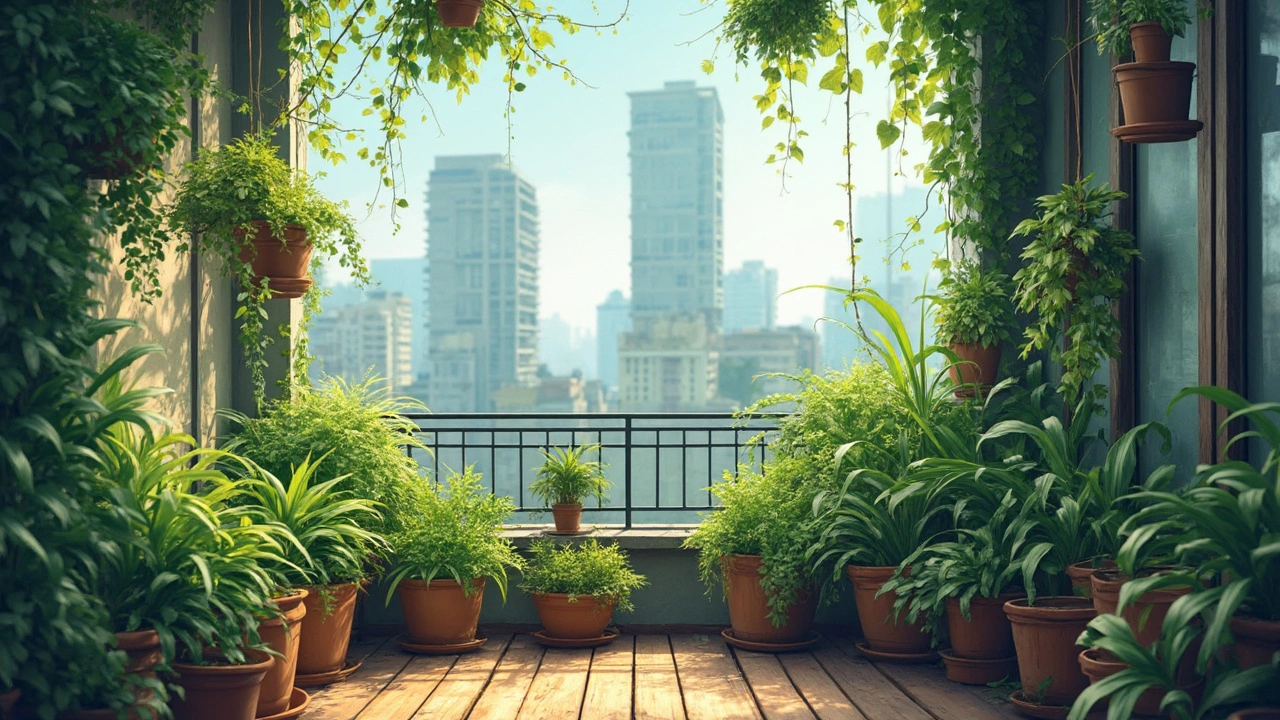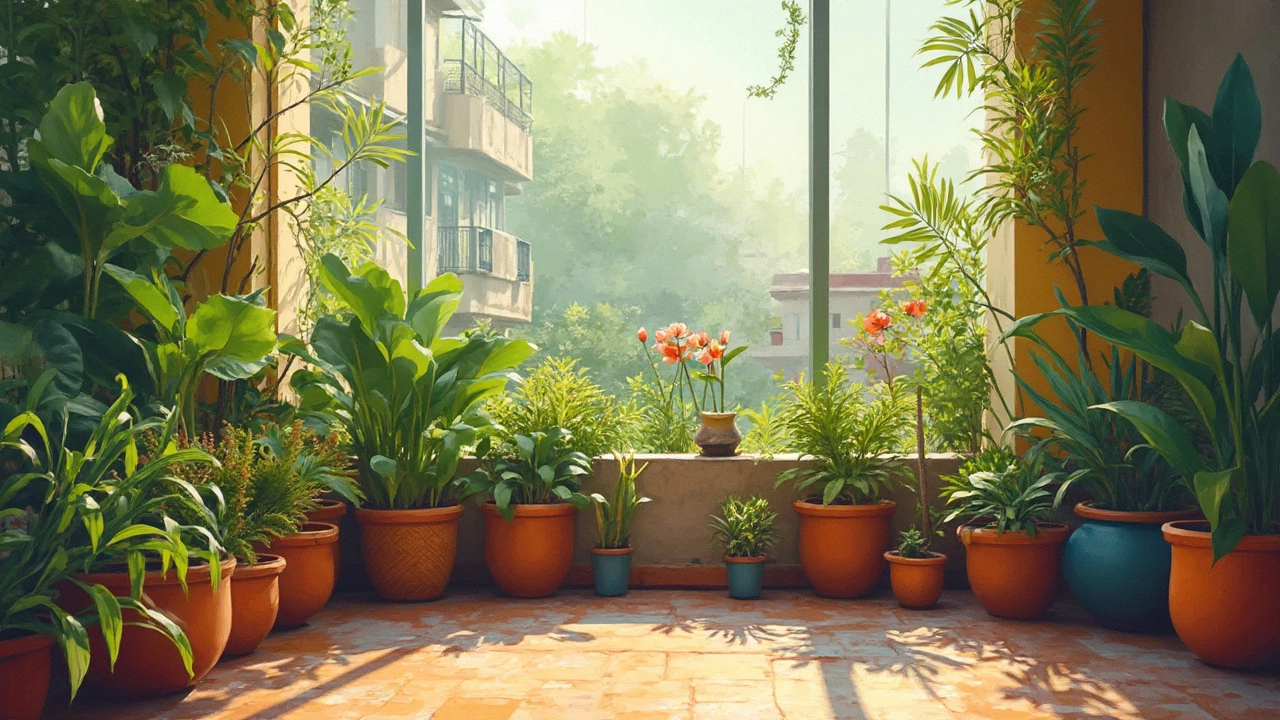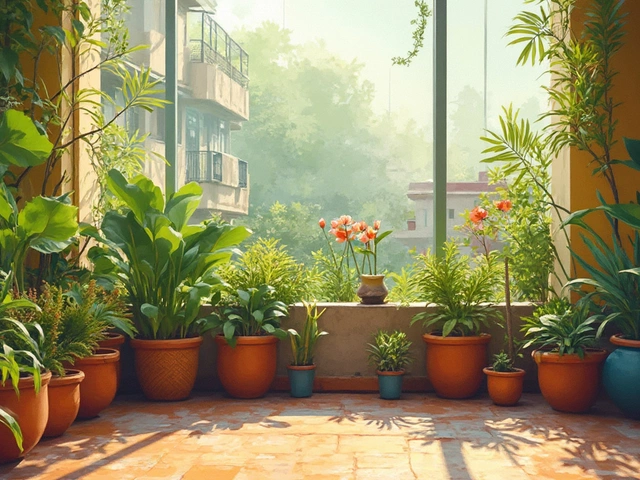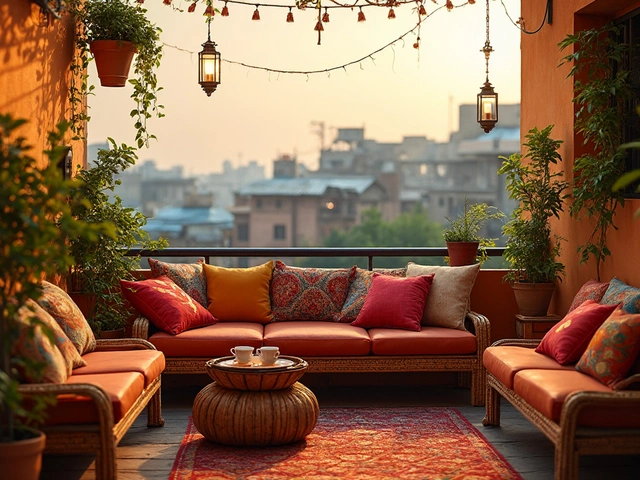Setting up a balcony garden can be both exciting and a bit daunting, especially when space is limited. Ever thought about which plants to start with? The trick is selecting ones that thrive in your balcony's unique environment. Take note of the sunlight it receives—this will be your guide in picking the right green friends.
Before anything else, spend a day observing the sun's movement across your balcony. Is it mostly sunny all day, or does it bask in morning sunlight only? This will help you pin down whether you need sun-loving plants like succulents, or shade-tolerant ones like ferns. Once you've got this sorted, you can start planning the fun part—the arrangement!
Arranging your plants can turn your balcony into a lush urban oasis. Think vertical! Use shelves, hangers, or even a vertical garden wall to maximize space. Not only does this make your balcony look fuller, but it also ensures each plant gets its share of sunlight.
Remember, a mix of heights and plant types can add visual interest and create a more dynamic space. Pair tall plants with cascading ones to fill up that vertical space beautifully. It's all about creating a balance that's pleasing to the eyes and beneficial for plant health.
- Choosing the Right Plants
- Understanding Sunlight and Space
- Creative Arrangement Tips
- Maintaining Your Balcony Garden
Choosing the Right Plants
Picking the right plants for your balcony isn't just a matter of choosing what looks pretty. It's all about understanding your space and making smart choices. Start by considering your balcony's unique environment. Does it face the sun all day, or do you have more of a shaded nook? This will guide you toward the right types of plants.
Sun-loving Beauties
If you've got a sun-drenched balcony, you're in luck because many popular plants love soaking up those rays. Think about adding succulents, lavender, or rosemary. They're easy to care for and enjoy basking in the sun.
Shade-friendly Choices
If your balcony enjoys more shade, don't worry—you've got options too. Ferns, hostas, and peace lilies thrive in shaded areas. These plants will bring life to even the gloomiest corners of your balcony.
Consider Growth and Maintenance
Another thing to consider is the growth and maintenance of your chosen plants. How much care are you willing to give? Some plants, like succulents and cacti, require minimal attention, making them perfect for busy folks. On the other hand, if you fancy a bit more of a challenge, try out herbs or small flowering plants.
Mix and Match
Don't be afraid to mix your plant types. Combining different textures and colors can add interest and vibrancy to your space. Group plants with similar needs together for easier care. You might want to create a variety of heights with taller plants at the back and shorter ones upfront for a visual treat.
Container Considerations
Finally, thinking about containers is just as important. Make sure there are enough drainage holes to keep your plants healthy. Clay pots, hanging baskets, and vertical planters are all great choices for small spaces.
With a little planning, you can transform your balcony into a personal oasis that fits your lifestyle and the unique characteristics of your space. Enjoy experimenting with different plants and arrangements to find what makes your balcony garden thrive!
Understanding Sunlight and Space
Let's talk sunlight. Your balcony plants' success depends significantly on understanding the sunlight dynamics of your space. Start by noting how much light your balcony receives throughout the day. This can vary wildly depending on your location, building layout, and even the time of year.
Observing Sunlight Patterns
Most balconies fall into one of three categories: full sun, partial sun, or shade. A full sun balcony receives more than six hours of direct sunlight daily. Partial sun means roughly three to six hours, while shade involves less than three hours of useful light.- Full Sun Spaces: Ideal for sun-hungry plants like tomatoes, lavender, and most succulents.
- Partial Sun: Look for versatile plants such as begonias or impatiens, which can handle varying light conditions.
- Shade: Perfect for ferns, hostas, or peace lilies, which thrive without direct sunlight.
Understanding how much sunlight your outdoor garden receives will also guide you in stacking your plants. Consider hanging baskets or taller containers in shadier zones, with floor-level pots in brighter spots.
Maximizing Your Space
Urban balconies can feel cramped, so smart use of space is crucial. Think vertical! Installing shelves or hangers lets you fit more balcony gardening options without overcrowding. Aim for an accessible layout—nobody wants to knock over a pot squeezing past!Here's a little trick: Try using reflective surfaces like mirrors or light-colored planters to bounce more light onto your plants. This is particularly useful for balcony plants in partial sun areas.
Data Snapshot: Urban Balcony Dimensions
| Average Balcony Size | Light Considerations |
|---|---|
| 80-100 sq ft | Assess shadow patterns hourly |
| 30-50 sq ft | Best for vertical gardens |
Understanding these elements helps create an outdoor garden that's not only beautiful but sustainable. With a bit of observation and clever planning, your plants will thank you with lush, thriving greenery year-round.

Creative Arrangement Tips
Transforming your balcony into a stunning green haven isn't just about having the right balcony plants; it's also about how you arrange them. The way you set up plants can make your space feel bigger, more vibrant, and ensure that every plant gets a chance to thrive.
Play with Heights and Layers
Think of your balcony garden like a lively conversation—it's more interesting with variety and depth. Use a mix of plant heights to create layers. Tall plants in corners or at the back can offer privacy while mid-sized and smaller plants fill in the front. Hanging plants can add an additional, lush overhead layer.
"A well-arranged garden is as much a work of art as it is a living space." - Jane Doe, Gardening Expert
Vertical and Horizontal Spaces
Maximize every inch of your balcony by going vertical. Shelves, hanging pots, or trellises can add dimension to even the smallest spaces. This allows you to showcase your plants prominently, plus it's a great way to ensure each plant gets its needed space and light.
Mix Up Textures and Colors
Combine different plant textures and colors to create an impressive display. Pairing soft, feathery ferns with striking succulents can add a dramatic flair. Alternatively, leafy greens juxtaposed with flowering plants can provide a beautiful contrast, making your garden pop with color.
Functional Decor
Consider incorporating functional decor such as benches with built-in planters or a small table surrounded by containers. This can make your balcony feel like an inviting extension of your home.
| Plant Type | Sunlight Needs | Recommended Height |
|---|---|---|
| Succulents | Full Sun | Short |
| Ferns | Partial Shade | Medium |
| Climbing Plants | Varies | Tall |
By putting these creative arrangement tips into action, you can create a balcony that's not only beautiful but also a practical place to relax and enjoy nature. And who wouldn't want a bit of nature's tranquility right at home?
Maintaining Your Balcony Garden
Creating a stunning balcony garden is one thing, but keeping it happy and healthy is another. Regular care is crucial to ensure your plants flourish in their cozy little urban oasis.
Watering Wisely
Water is essential for plant growth, but how often should you water your balcony plants? It depends on the plant type and the season. In summer, they might need water daily, especially if your balcony is sun-drenched. In cooler months, you can cut back, but remember, keeping the soil consistently moist (not soggy) helps fend off stress.
Feeding Your Greeneries
Fertilizers are like multivitamins for plants. For potted plants, use a balanced, slow-release fertilizer every couple of months. This ensures they get all the nutrients they need without overwhelming them. Keep in mind that over-fertilizing can do more harm than good.
Pest Patrol
Even a balcony garden isn't immune to pests. Regular checks are key. Wipe leaves with a damp cloth to keep them clean and deter bugs. If you notice any uninvited guests like aphids or spider mites, natural remedies like neem oil or insecticidal soap do wonders. As renowned horticulturist Jane Smith puts it,
"A healthy plant is the best defense against pests."
Pruning and Tidying
Don't be afraid to prune your plants. Snipping away dead or overgrown parts keeps them neat and encourages new growth. Remember, a well-maintained plant looks better and is usually healthier too.
| Task | Frequency |
|---|---|
| Watering | Check daily |
| Fertilizing | 2-3 months |
| Pruning | Monthly or as needed |
| Pest Check | Weekly |
Keeping a balcony gardening schedule can make things easier. Stick a checklist on your fridge or set reminders on your phone—whatever gets the job done.




